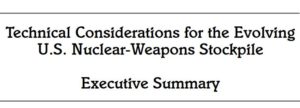Yesterday the National Nuclear Security Administration posted the executive summary of a study by JASON, the independent science advisory group, of the “3+2” program to replace most of the U.S. nuclear weapons stockpile with a suite of new weapons. The summary is deeply skeptical of the 3+2 approach, noting several potential problems and offering only lukewarm support for some of the benefits that the programs’ supporters tout.
 The classified study, “Technical Considerations for the Evolving U.S. Nuclear-Weapons Stockpile,” was completed in January 2015 after Congress mandated in the fiscal year 2014 appropriations bill that the NNSA engage JASON to study the 3+2 plan. As it often does, JASON produced an unclassified executive summary with its report, including a short version of their findings and recommendations. It wasn’t until yesterday, however, a year and a half after the study was completed and six months after UCS requested a copy that the NNSA finally released the unclassified summary.
The classified study, “Technical Considerations for the Evolving U.S. Nuclear-Weapons Stockpile,” was completed in January 2015 after Congress mandated in the fiscal year 2014 appropriations bill that the NNSA engage JASON to study the 3+2 plan. As it often does, JASON produced an unclassified executive summary with its report, including a short version of their findings and recommendations. It wasn’t until yesterday, however, a year and a half after the study was completed and six months after UCS requested a copy that the NNSA finally released the unclassified summary.
UCS has long been critical of the 3+2 plan, which will replace the existing four missile warheads—the W78s and W87s on land-based missiles, and the W76s and W88s on sub-based missiles—with three “interoperable” warheads. It will also supplant 4-5 versions of the B61 gravity bomb with one while updating the W80 warhead for the air-launched cruise missile, making two weapons for the air leg. Hence the plan is called “3+2.” As initially described in the NNSA FY2014 Stockpile Stewardship and Management Plan, each of the interoperable warheads will have “a common NEP [nuclear explosive package, the fissile core of a nuclear weapon] integrated with non-nuclear systems that maximize the use of common and adaptable components” that can be used on either land-based or sub-based missiles.
Many of our findings are reflected in the JASON executive summary, which may help explain why the NNSA was so slow to release it. Highlights similar to UCS findings include:
- The “3+2” term is misleading; JASON notes that the program will create “three types of NEPs, each deployed in two types of aeroshells, which translates into six types of re-entry vehicles.” Each of the six warhead assemblies “must be qualified and tested independently as an integrated warhead test assembly.” In other words, the NNSA’s plan should be called 6+2.
- Three of the primary goals for 3+2 are: having three warheads for each missile-based leg of the triad; making the NEPs interoperable; and using insensitive high explosives (IHE) throughout the stockpile. Each of these goals can be achieved without the other two. (However, achieving one goal may interfere with achieving other goals, as noted in #3 below.)
- “JASON is not aware of a compelling analysis of the net impact of commonality requirements on cost, schedule, or risk associated with NNSA’s tasks under a “3+2” strategy.” This mirrors our call for additional cost analysis of 3+2 before deciding to proceed.
- Despite what many seem to believe, the potential for a reduction in the hedge (non-deployed warheads held in reserve) is not a function of interoperability, but of having three warheads for a given leg of the triad.
The JASON study had additional troubling findings:
- Pursuing a common NEP or other common components can lead to sub-optimal designs, because the components must meet requirements for two systems, rather than being designed explicitly for one. In other words, by pressing for interoperability, NNSA may develop warheads that will not work as well as warheads designed specifically for one missile.
- “Program instability poses a significant threat to NNSA’s mission critical capabilities. . . As presented to JASON, the applications of NNSA capabilities to the “3+2” strategic vision to date and in future planning scenarios is erratic.” (Emphasis in original.) This seemingly refers, at least in part, to the decision to delay the first interoperable warhead by five years, plus generally poor planning on the NNSA’s part.
- Decisions made to pursue one goal of the 3+2 plan can negatively affect other high priorities for the stockpile. As JASON puts it, “[c]hoices regarding commonality, performance, diversity, and intrinsic safety and security features are in a competitive design trade space. A choice of NEP interoperability or of an all-IHE stockpile may force a reduction in primary yield margins, for example.” (Emphasis in original.)
- Requiring both IHE and interoperability will alter the flight dynamics for the warheads carried by the land-based and sea-based missiles “and could alter reliability or targeting accuracy.”
In light of these findings, JASON made two recommendations:
- The NNSA “must maintain stable and predictable execution of program elements and work flow while sustaining essential mission capabilities within expected budget levels.” This unspecific proposal is again seemingly a criticism of the changing schedule of the 3+2 plan, as well as the increased costs that it could incur.We would argue that the approach we recommend, pursuing straight-forward life extension programs as needed for warheads that are required for the stockpile, would be a more effective approach to following the JASON recommendation than the 3+2 plan would be.
- The NNSA must study the implications of the potential tradeoffs between “surety, component commonality, and the number of warhead types on each Triad leg to better inform “3+2” decisions.”
In short, JASON seems unconvinced of the value of the 3+2 plan as currently laid out, and believes much more study is required. Indeed, perhaps the most remarkable feature of the executive summary is the lack of clear praise for any part of the 3+2 program. That may be the most telling indictment of this flawed and risky approach and—we hope—a bellwether that the proposal will be abandoned before further time and resources are wasted on it.
